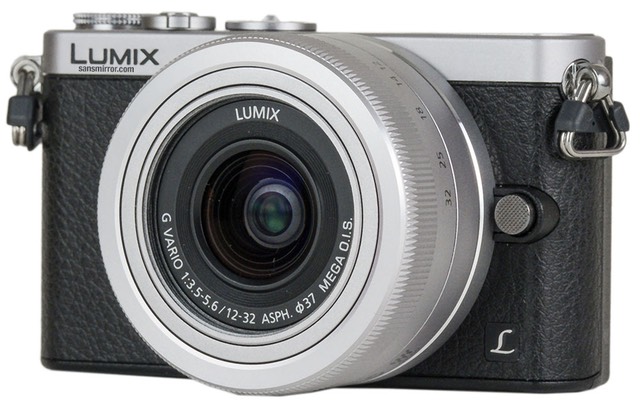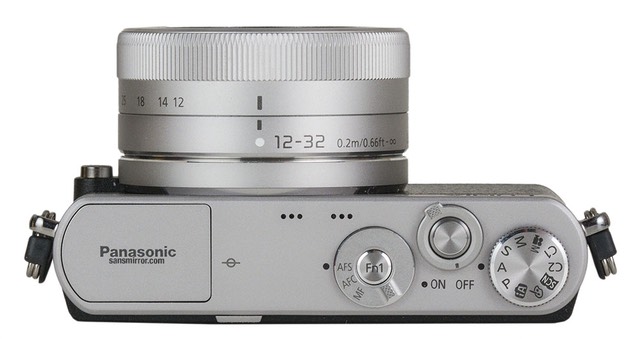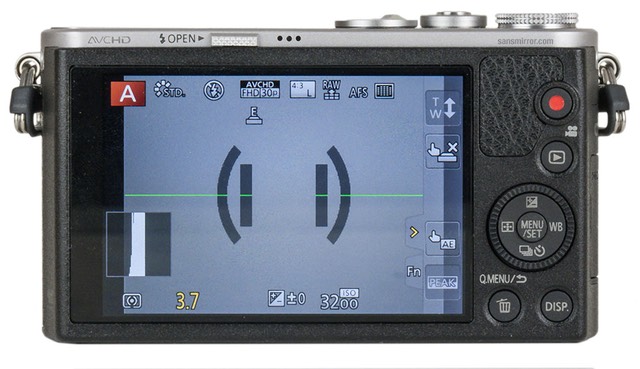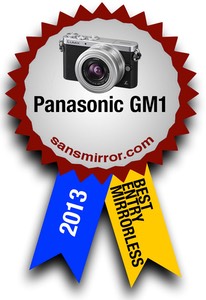
What is It?
The Panasonic GM1 is a very small m4/3 camera that attempts to be a compact camera replacement yet with a bigger sensor and interchangeable lenses. As small as many of the m4/3 cameras are, the GM1 makes them all look substantially bigger, which is quite a feat. If it weren't for lenses, this would be a shirt pocket camera.
Speaking of lenses, the kit lens with the GM1 is the new 12-32mm f/3.5-5.6, which collapses to 1.25" (32mm) when mounted on the camera. This lens has Mega-OIS stabilization built in (i.e. not sensor stabilization). There are prime lenses in this focal range that aren't as small (though they have faster apertures).
Overall, the GM1 is lighter and smaller than a Sony RX100II, believe it or not, though the lens sticks out front more. Indeed, I think the primary competitor to the GM1 is the RX100II. I'll get to that towards the end of the article.
With the GM1 sitting on my desk amongst a bunch of DSLRs I'm working with at the moment, it almost looks like someone put a toy amidst the black giants. No matter how you look at it, Panasonic did a remarkable engineering job in making a relatively complete, high-performance camera in the petite GM1. As you'll discover, there are compromises that derive from the smallness, but generally someone truly seeking small will often tolerate reasonable compromises. So the question will quickly become were those compromises reasonable?
Like the other Panasonic m4/3 cameras these days, the GM1 has a 16mp sensor at its heart. No compromise there. The body is a magnesium-alloy tube with aluminum caps up top and on the bottom. No real compromise there, either. Out back is a 3", 1.04m dot touch sensitive LCD. If there's a compromise it's that the LCD doesn't tilt and that there is no EVF option for the camera (no hot shoe in which to mount it, for one thing). The camera has a low-power pop-up flash, the ability to record 1080P/30 video, stereo microphones up top, focus peaking for manual focusing, a smallish Mode dial, even a dedicated Fn button and WiFi capability.
So where are the compromises? The big ones are: battery size, no hot shoe, no EVF option, combo mechanical/electronic shutter with only 1/50 flash sync, and no grip (Panasonic has an awkward optional one).
Wait a second, 1/50 flash sync? Yes. This is one of the areas where the Panasonic engineers got clever to get smaller size: the shutter motor. The GM1 actually has an electronic shutter option and a rather simple mechanical shutter that only operates up to 1/500 and only syncs to flash at 1/50. The electronic shutter allows 1/16,000 second shutter speeds and up to 40 fps shooting (though at 3.8mp). It also means the camera can be configured for silent shooting. The bad news is that the electronic shutter has significant rolling shutter effect (not all of the frame is captured at the same moment; it takes almost a tenth of a second for the camera to grab all the data from top to bottom of the sensor in electronic shutter mode). Things in motion may have a motion artifact in them, therefore. If you've ever watched a video of a helicopter or prop airplane and wondered why the rotating blades were curved, they weren't: that was rolling shutter in action.
In terms of controls the GM1 is reasonably bereft. On the top plate we have a Mode dial, on/off switch around the shutter release, and a Fn1 button within a Focus Method switch. On the back we have a recessed Record video button, Play, Delete/QMENU, and Display buttons, along with a compact-camera style Direction pad (MENU button in center, dial around outer edge, four pad positions overloaded to be additional "buttons" [exposure compensation, WB, Self Timer, focus point]). That's it. Everything else is done via touchscreen or menu. It would have been nice to have one control ring up top (e.g. Rear Command dial), maybe another Fn button. Still, as I'll point out in the next section, Panasonic went for a reasonable alternative to lots of controls on the camera body.
I would say that the top plate controls seem a little under thought out and a bit on the small side. But "small" is the operative word in everything with GM1, so either you like that or not. Basically, the GM1 is an "all in on the small" design.
A few advanced features you might not have expected are the Stop Motion and Time Lapse functions.
The camera is made in China.
How's it Handle?
Like a bar of soap, unfortunately. Both the material Panasonic uses and the small size and shape mean that it is not easily gripped, especially if you have larger hands. But more to the point, if you're going to do anything with controls while shooting (other than the shutter release), you're going to lose grip on the camera. Something like Richard Franiec's grip is probably a necessity if you want to feel comfortable with the camera while shooting. With gloves or if the surface gets wet in any way, consider that last sentence to be doubly emphasized.

There's also the size/mass thing at work. As long as you stick to the kit lens or the pancake primes, the GM1 is appropriately sized and massed. Put pretty much anything else on it and it becomes front heavy and you immediately switch to a hands-under-lens holding situation. That's not a bad thing, as you're likely to be holding the camera more stably with a hand under the lens, but it really does change the way you handle the camera.
The camera defaults to having WiFi assigned to the Fn1 button. This shows a bit how Panasonic targeted the GM1: they see it as a high-end smartphone accessory. I suppose if that's how you're using it, that's fine, but most folk will want to change this to something more useful while shooting, as there aren't many other direct controls available on the camera.
The good news is that the Panasonic touch screen controls are relatively refined and even programmable these days (you can program up to five "touch Fn buttons"). Coupled with the QMENU button, there's not a lot you have to dip into the menus for while shooting. However, gloves would be a problem using the GM1; you'd need to menu dive if you've got gloves on, and thick gloves make it near impossible to hold the camera or operated the tiny controls.

While some have written that the control dial around the Direction pad is too "fiddly," I think it works okay and feels decent for its size. The real problem is that because you're trying to keep grip on the camera, you're highly likely to touch the Direction pad and accidentally start a setting without noticing. Given how well the QMENU and touch screen work to provide "controls," I personally would have opted to not put functions on the Direction pad (and perhaps made those programmable options).
Another of the "too small" problems is that the pop-up flash isn't going to clear most lenses bigger than the kit lens. No big loss, as it only has a maximum distance of 4m (12 feet or so). Speaking of the kit lens, it's one of those "rotate to extend to shooting position" lenses. I'm not a big fan of that, as it just slows down the "on" speed of the camera: flip power switch, take off lens cap, rotate lens into position, now you're ready to shoot. This is really a camera that could have used a quick power zoom and power lens cap. Why? Because the small battery size means that you're going to be aggressive with powering off. Yes, you can dial up the power settings to go into standby faster, but still, you're going to want to power completely off more than you would with a bigger camera with a bigger battery.
The kit lens also doesn't have a focus ring. So how do you manually focus? Via the touch screen. This isn't as bad as you might think, but it's definitely not what you're probably used to.
In bright light (e.g. snowy scenes), the LCD just isn’t very visible. That’s a problem with a camera that most will think of as a take-anywhere camera. The beach, skiing, glaciers, and a few other locales are going to be problematic. Get a small hood loupe and hang it around your neck when using this camera in bright light.
While all this may sound negative, it's really a choice you have to make. Do you really want a truly small m4/3 camera body? If so, the smallness is simply going to have some implications on use, as you can't fit tons of controls on a small body ergonomically. As I pointed out, Panasonic probably put too many controls on the camera (the Direction pad controls). In my book, a small lean camera needs a small lean user interface. Panasonic comes very close, but doesn't fully score on this aspect with the GM1 design.
That said, the GM1 is frighteningly small and light for an interchangeable lens camera. The body is actually smaller than a Sony RX-100II compact camera, for instance. We're deep into compact camera size here, and that's a bit of a handling plus: you don't need a big bag or pocket to carry this camera around in, meaning that it's likely to be carried around more.
My advice? Get a grip, change the Fn button settings, consider a prime lens (no rotating to be ready to shoot), have a hood loupe handy for bright light, and try not to brush against the Direction pad.
How's it Perform?
Battery: I was surprised to get more than 2000 images out of a charge when shooting time lapse (and yes, I was forcing focus on each shot). Of course, this was taking shots very rapidly (one a second). Still, this really indicates that the big drain on the camera will be the amount of time you keep the LCD active.
That said, in general shooting, 250 shots would be what I consider a good performance from the camera/battery. I achieved that more than once, but I also didn't leave the camera active that much. If you're going to use WiFi, be prepared for constant battery changing, by the way. Also, note that the GM1 doesn't have NFC, so you end up having to manually set up the connection. Pity, because Panasonic's iOS and Android apps are a little better behaved than many of the competitors and can actually be used to control the camera without getting the constant crashes I've found with some of the other vendors' implementations, at least on my iPhone. Short story: bring extra batteries, and even more if you're a WiFi addict.
Writing to Card: For JPEG shooters, the camera pretty much will fill a card to capacity without a hiccup, even at 5.3 fps (at the special 40 fps setting, the buffer is 39 smaller frames, though). Raw shooters are going to find a very limited buffer, basically 6 frames at the 4.7 fps frame rate, 15 at 2.2 fps (lower if you shoot raw+JPEG). I found that the camera cleared the buffer fast, however. Faster than a lot of other cameras in its price class, actually. It seems like Panasonic is trying to keep camera card performance up nearer state-of-the-art than a few other companies I can think of.
Focus: For single focus acquisition (static subjects), I really didn't have any problems with the focus speed in this mode, even in lower light conditions. Continuous focus (moving subjects) was an interesting, more complex issue. The camera has trouble with continuously moving subjects. It simply might not catch up with fast motion, taking out of focus images. On the other hand, if the subject stops for a moment (or your camera movement stops), the camera fairly quickly catches up and acquires focus. Unfortunately, it's a little tough to predict what your subject is going to do, so you're sort of at the whim of the camera here.
Image Quality: in JPEGs I sense a Hue shift. Reds and Greens drift a little yellow, Yellow drifts green. Indeed, at the default settings I'd have to say that the RGBYMC section of the ColorChecker chart was probably the least accurate I've seen in awhile. All the colors were shifted from where they should be. The color isn't unpleasing, but it's definitely not accurate. Skin tones seem a slight bit orange to me, too.
The other problem with JPEGs is the noise reduction. It's a bit blotchy and generates rough edges on lines. In some cases, this generates faux detail that makes it look the camera is resolving more than it is, in other cases it just roughens up textures and tonal areas. Yet in other areas details just disappear. If I had to characterize it, the camera's processing engine has trouble with random detail (blotchiness and detail disappears) and is more optimized for regular detail (rough edges but edges). Looking at GM1 versus E-P5 details at ISO 6400 is like some sort of strange alien intelligence test. Neither gets it right, but in some areas you'll prefer the Panasonic approach over the Olympus one, in others the inverse. Overall, though, I prefer Olympus’ handling of JPEGs. It's a little more predictable and a little less digital feeling. And on fine random detail, there's less smudging, which is a dead giveaway of NR.
One thing to be wary of is using the GM1 in frequency-based artificial lighting with the electronic shutter. You'll get clear banding in some situations because the frequency of the lighting and the rolling electronic shutter are fighting each other.
In terms of low light capability, the GM1 is pretty decent, as have been most recent m4/3 bodies:

(Note that we’ve changed the balls we use at the court, so the ball color is darker than you might have seen in previous samples from other cameras.)
Overall, the GM1, when stressed on underexposure like this at ISO 3200, is a teeny bit noisier than I’m used to with the bigger sensor cameras, but, with care, perfectly acceptable. The camera is retaining detail in the net and ball surface, though it’s picking up slight edge noise and blocking up the color slightly. Still, a very good performance for a sensor this size, and better than a Nikon D300 at ISO 3200, which goes to show how far sensor technology has come. The JPEG actually looks a bit better in color than this raw conversion, though it does so by masking some low level detail (e.g. net threading).
Final Words
The GM1 is a bit of a conundrum. Most certainly there are compromises in the features and design, but compromises of some sort are necessary to get a high performing camera with interchangeable lenses down to this size. So you have to examine the compromises made versus your need for smallness.
As an "only camera" the GM1 doesn't make nearly as much sense to me as it does as a "carry everywhere" option for existing m4/3 users. That's especially doubled if you happen to have the pancake prime lens set handy.
I'm sure Panasonic is marketing the GM1 as "purse friendly" in the Asian markets, trying to entice more women to buy it, and even for men that's a pretty good way to think about it. Consider it jacket pocket friendly. Or cargo pants pocket friendly. Or laptop case friendly. The GM1 is a good accessory camera, in other words. It wouldn't be my main shooter, but keeping it in a jacket pocket with a complimentary lens on it to what I'm normally shooting with on my Olympus OM-D E-M1, for example, seems like a nice option to have.
In short, the GM1 isn't for everyone. But it certainly will appeal to some. Whether you're one of those are not is something that you have to decide based upon your needs. If I were an all-m4/3 shooter, for instance, I'd be opting for a GM1 as my pocket camera of choice over virtually any compact camera. If you're not an m4/3 shooter, then other options start to look more interesting, most notably the slightly larger Sony RX100II (though it has a fixed zoom lens and a smaller sensor).
So how does the GM1 stack up to the RX100II?
- Sensor — 16mp m4/3 versus 20mp 1" probably tilts in the GM1's favor
- Lens — 24-64mm (equivalent) f/3.5-5.6 versus 28-100mm f/1.9-4.9 probably tilts in the RX100's favor, at least until you consider that the GM1 can use other lenses
- Composing — Both have 3" LCDs, but the Sony has an optional EVF and a tilting LCD
Yeah, tricky. The Sony is more a shirt pocket camera and the GM1 more jacket pocket, if that helps you decide. For me, the EVF option for the Sony was the kicker in my decision making, but boy would I really love to change lenses on the Sony. So I'd say this: if you want to change lenses, buy the GM1; if you want to "look through a viewfinder" buy the Sony and get the optional EVF (though be prepared for sticker shock).
That said, the GM1 is enough of a camera that I've declared it my Entry Mirrorless Camera of 2013 winner. Barely. Still, it occupies a very unique position in the market, and other than its smallness—which is also it's most appealing attribute–it doesn't have any major faults that are going to get in the way of entry-level shooting.

2018: this model is out of production and no longer available new. But used copies can easily be found. Also look at a current model, which would be either the GX850 or GX9.